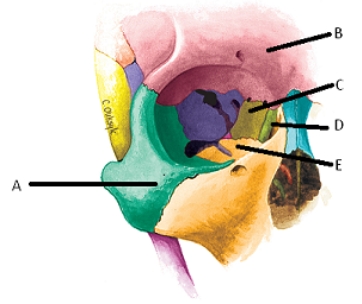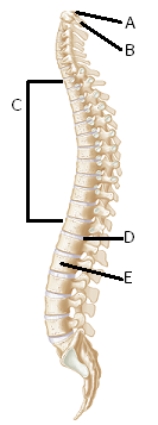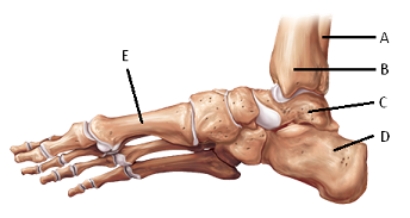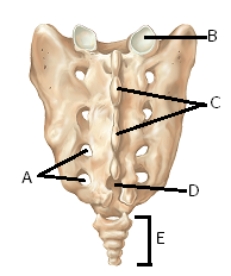A) anterior superior iliac spine.
B) sacroiliac joint.
C) symphysis pubis.
D) iliac fossa.
E) ischial tuberosity.
G) D) and E)
Correct Answer

verified
Correct Answer
verified
Multiple Choice
A cleft palate results from incomplete development of the _______
A) palatine bones.
B) maxillae.
C) mandible.
D) vomer bone.
E) frontal bone.
G) A) and E)
Correct Answer

verified
Correct Answer
verified
Multiple Choice
 -The figure shows the bones of the right orbit. What bone does "C" represent?
-The figure shows the bones of the right orbit. What bone does "C" represent?
A) frontal
B) maxilla
C) zygomatic
D) lacrimal
E) ethmoid
G) A) and D)
Correct Answer

verified
Correct Answer
verified
Multiple Choice
Three-year old Trevor is admitted to the hospital with stenosis (narrowing) of the foramen magnum, which directly affects which of these structures?
A) optic nerve
B) internal jugular veins
C) facial and vestibulocochlear nerves
D) spinal cord
E) carotid arteries
G) A) and B)
Correct Answer

verified
Correct Answer
verified
Multiple Choice
Which of the following bones is part of the axial skeleton?
A) scapula
B) radius
C) clavicle
D) coxa
E) rib
G) D) and E)
Correct Answer

verified
Correct Answer
verified
Multiple Choice
A patient in a skiing accident is told that the lateral side of the ankle joint has been crushed. The bone that has been injured is the
A) femur.
B) tibia.
C) fibula.
D) calcaneus.
E) talus.
G) None of the above
Correct Answer

verified
Correct Answer
verified
Multiple Choice
The large bone in the thigh is the
A) tibia.
B) femur.
C) fibula.
D) ischium.
E) coxal bone.
G) All of the above
Correct Answer

verified
Correct Answer
verified
Multiple Choice
Failure of the palatine processes of the maxilla to fuse properly during development results in a
A) cleft chin.
B) deviated septum.
C) cleft lip.
D) cleft palate.
E) clogged sinus.
G) A) and E)
Correct Answer

verified
Correct Answer
verified
Multiple Choice
The common name of the tibia is the
A) zygomatic bone.
B) finger bones.
C) kneecap.
D) breastbone.
E) shinbone.
G) A) and B)
Correct Answer

verified
E
Correct Answer
verified
Multiple Choice
The thumb and big toe are similar in that
A) both contain carpal bones.
B) each have three metatarsals.
C) both are composed of sesamoid bones.
D) both have two rather than three phalanges.
E) both have three rather than two phalanges.
G) A) and C)
Correct Answer

verified
Correct Answer
verified
Multiple Choice
The acromion process
A) is part of the clavicle.
B) articulates with the coracoid process.
C) forms the most inferior part of the glenoid fossa.
D) has no function.
E) has an articulation with the clavicle.
G) All of the above
Correct Answer

verified
Correct Answer
verified
Multiple Choice
 -What does structure "D" represent?
-What does structure "D" represent?
A) atlas
B) axis
C) body of vertebra
D) intervertebral disk
E) thoracic region or curve
G) A) and B)
Correct Answer

verified
Correct Answer
verified
Multiple Choice
A blow to the shoulder often breaks the clavicle, but very seldom breaks the scapula. Suggest why.
A) The scapula is larger than the clavicle.
B) The clavicle provides the only bony attachment of the pectoral girdle to the body.
C) The scapula is more protected by muscle.
D) When the body is moving forward, the clavicle is more likely to be struck than the scapula.
E) All of these are valid explanations.
G) C) and D)
Correct Answer

verified
Correct Answer
verified
Multiple Choice
The humerus articulates with the ulna at the
A) medial epicondyle.
B) lateral epicondyle.
C) capitulum.
D) radial fossa.
E) trochlea.
G) A) and C)
Correct Answer

verified
E
Correct Answer
verified
Multiple Choice
Which skull canal does the internal carotid artery pass through?
A) nasolacrimal canal
B) external auditory canal
C) jugular foramen
D) carotid canal
E) foramen ovale
G) C) and E)
Correct Answer

verified
Correct Answer
verified
Multiple Choice
The lateral malleolus is part of the
A) fibula.
B) scapula.
C) humerus.
D) ulna.
E) femur.
G) C) and D)
Correct Answer

verified
A
Correct Answer
verified
Multiple Choice
Judd has a fractured coxal bone, which means he has a broken
A) arm.
B) wrist.
C) knee.
D) pelvis.
E) ankle.
G) A) and E)
Correct Answer

verified
Correct Answer
verified
Multiple Choice
 -The figure illustrates a medial view of bones of the right foot. What does "A" represent?
-The figure illustrates a medial view of bones of the right foot. What does "A" represent?
A) calcaneus
B) fibula
C) metatarsals
D) tibia
E) talus
G) B) and E)
Correct Answer

verified
Correct Answer
verified
Multiple Choice
Which of the following bony features is not associated with the skull?
A) obturator foramen
B) stylomastoid foramen
C) cribriform plate
D) foramen rotundum
E) pterygoid canal
G) A) and C)
Correct Answer

verified
Correct Answer
verified
Multiple Choice
 -The figure illustrates the sacrum. What structure does "E" represent?
-The figure illustrates the sacrum. What structure does "E" represent?
A) coccyx
B) sacral hiatus
C) superior articular facet
D) median sacral crest
E) posterior sacral foramina
G) A) and E)
Correct Answer

verified
Correct Answer
verified
Showing 1 - 20 of 173
Related Exams